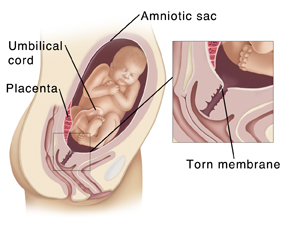Pregnancy and Childbirth: Premature Rupture of the Membranes (PROM)
During pregnancy, the baby is surrounded in the uterus by the amniotic sac. The sac is also called the “bag of waters.” It protects and cushions the baby. Premature rupture of the membranes (PROM) is when the amniotic sac breaks before you go into labor. Normally, the sac breaks after labor begins and contractions have started. If PROM happens at 37 weeks or earlier in pregnancy, it's called preterm PROM.

Are you at risk for PROM?
Healthcare providers aren’t sure what causes PROM. But certain things seem to make PROM more likely. These are called risk factors. Risk factors for PROM include:
-
Lack of prenatal care
-
Smoking during pregnancy
-
Low body weight
-
Bleeding from the vagina during the 2nd or 3rd trimester
-
A past sexually transmitted infection (STI) or a past infection in the bag of waters
-
Being pregnant with more than 1 baby
-
Certain past medical procedures, such as:
The dangers of PROM
PROM can cause these serious problems:
-
Germs can travel from the vagina into the uterus and cause a dangerous infection.
-
The umbilical cord can be squeezed, reducing blood flow to the baby.
-
The placenta can separate from the wall of the uterus (placental abruption). This can lead to severe bleeding.
-
The baby can be born too early. This can cause breathing and nervous system problems.
Symptoms of PROM
Call your healthcare provider right away if you have any of these symptoms:
-
Fluid leaking or gushing from the vagina. This is the main symptom. Even though there is fluid loss, it keeps leaking because the baby is making more. The fluid can be clear or light yellow.
-
Bleeding from the vagina
-
Pain in the lower belly (abdomen) or in the low back
Evaluating PROM
Your healthcare provider will ask about your symptoms. Tell them if you have recently had contractions, bleeding from the vagina, sex, or a fever. They will then likely do the following:
-
Examine your vagina and cervix.
-
Take a swab of fluid from the vagina. This is examined to see if there is any amniotic fluid.
-
Do an ultrasound test to measure amniotic fluid in the uterus.
-
Check your baby’s heart rate.
Treating PROM
PROM is treated based on where you are in your pregnancy:
-
If you are 34 weeks or earlier, you’ll likely be admitted to the hospital. There you’ll be given antibiotics to prevent infection and to prolong the pregnancy. You may also be given medicine (steroids) to help the baby’s lungs mature. You and the baby will then be carefully watched for signs of infection. If there is enough amniotic fluid to test, it will be analyzed to check how well the baby's lungs are developing. The baby’s lungs will also be checked for how they’re developing.
-
If you are between 34 and 37 weeks, labor will likely be induced.
-
If you are at 37 weeks or later, and you don't go into labor on your own, your healthcare provider will advise inducing labor.
Follow-up care
Work with your healthcare provider. Together you can take steps to prevent PROM complications. This will help keep your health and your baby's health safe.